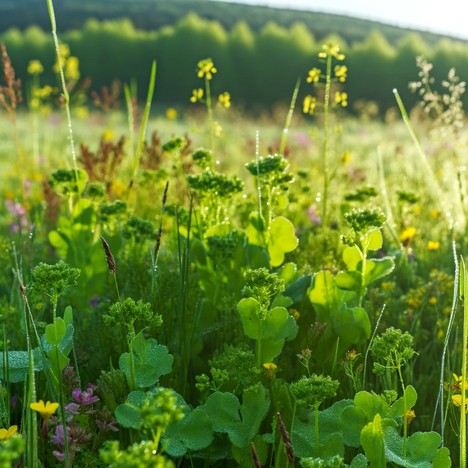Field cress

In the endless search for optimal nutrition for our four-legged friends, we often come across surprising ingredients that offer more than one would expect at first glance. One such ingredient is field cress, which is attracting increasing attention not only in human cuisine but also in dog food. In this article, we delve deep into the world of field cress, shed light on what it is and examine its advantages and disadvantages in our dogs' diet.
What is field cress?
Field cress, also known as Lepidium campestre, is a member of the cruciferous family and is closely related to broccoli, cauliflower and other health-promoting vegetables. It is known for its pungent, peppery flavor and is often used in salads, soups and as a garnish. But beyond the kitchen, field cress also has a number of health benefits that make it an interesting ingredient in dog food.
Benefits of field cress for dogs
- Rich in nutrients: Field cress is an excellent source of vitamins A, C and K, as well as minerals such as iron and calcium. These nutrients are essential for maintaining a healthy immune system, robust bone structure and optimal vision.
- Natural detoxification: Thanks to its high antioxidant content, field cress can help cleanse dogs' bodies of harmful toxins and reduce cell damage caused by free radicals.
- Aid digestion: The fiber contained in field cress can aid digestion and help maintain a healthy gut flora.
- Support weight management: Due to its low calorie content and high nutrient density, field cress can be a valuable addition to the diet of overweight dogs.
Possible disadvantages of field cress
- Allergic reactions: As with any new food ingredient, there is a risk of allergic reactions with field cress. Symptoms may include skin rashes, indigestion or breathing problems.
- Excessive consumption: Although field cress offers many health benefits, excessive consumption can lead to gastrointestinal discomfort. Moderation is key.
- Interactions with medications: Field cress contains vitamin K, which can affect blood clotting. This could cause problems for dogs taking anticoagulant medication.
Field cress is undoubtedly a nutrient-rich ingredient that, when dosed correctly, can be a valuable addition to your dog's diet. It offers a wealth of health benefits, from supporting the immune system to promoting healthy digestion. However, it is important to exercise caution when introducing new foods into your dog's diet and be aware of potential allergic reactions or other side effects. As with everything in nutrition, the same applies here: The dose makes the poison. Field cress can be a wonderful "green wonder food" for your dog, as long as it is fed in moderation.
If you notice any signs of hypersensitivity or poisoning in your dog, you should see your vet immediately. We are not a substitute for a vet, but we try to be as accurate as possible. Every dog reacts differently and we recommend you get a second opinion or consult your vet if in doubt.
Stay healthy and take good care of your four-legged friend!😊
Similar to Field cress
Watercress (Nasturtium officinale) is a winter-green, perennial plant that can grow up to 70 centimetres high. It has hollow stems that lie or float in water and leaves that are pinnate. The leaves...
Garden cress, scientifically known as Lepidium sativum, is a fast-growing, edible herb from the cruciferous family. Characterized by its pungent, peppery taste, it is often used in salads,...
Winter cress, also known by its botanical name Barbarea vulgaris, belongs to the cruciferous family and is native to many parts of Europe, North America and Asia. The plant is often prized for its...
Water mint, known by the scientific name Mentha aquatica, is a plant species native to Europe, Africa and Asia that prefers to grow in damp places such as riverbanks and wetlands. The plant is...


